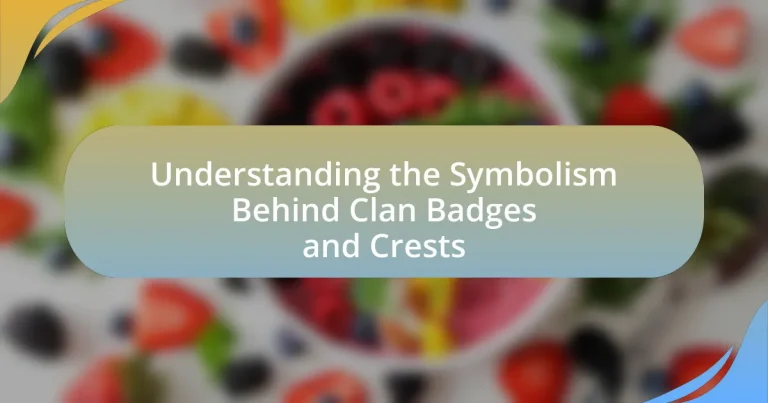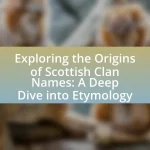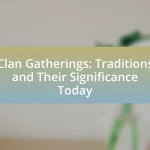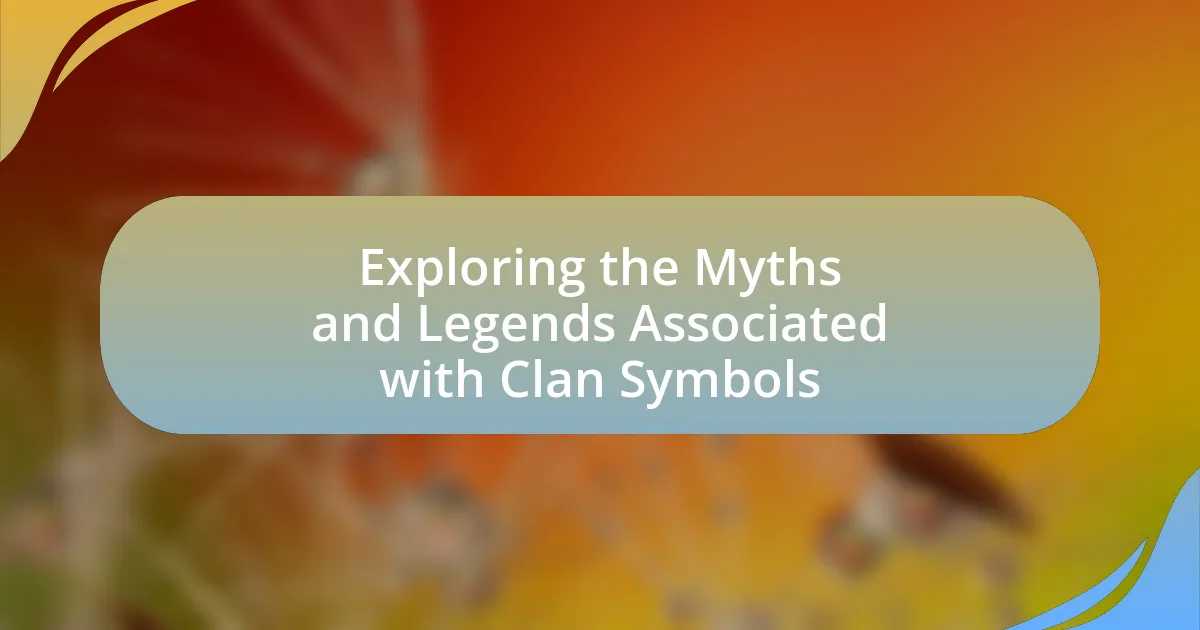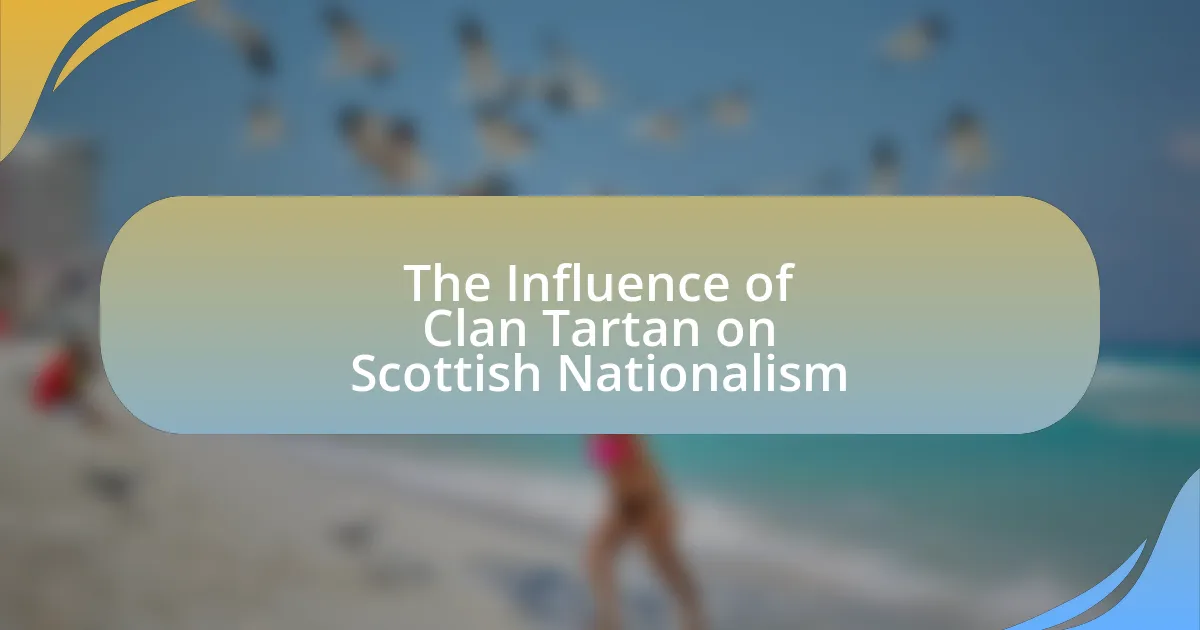Clan badges and crests are significant symbols in Scottish culture, representing the identity, heritage, and values of specific clans. This article explores the distinctions between clan badges and crests, their historical significance, and their role in fostering community and cultural identity. It delves into the symbolism of common elements found in these emblems, such as animals, plants, and colors, and discusses how these symbols convey messages about lineage and values. Additionally, the article provides insights into the interpretation of clan symbols, the importance of historical context, and best practices for creating new clan badges or crests.
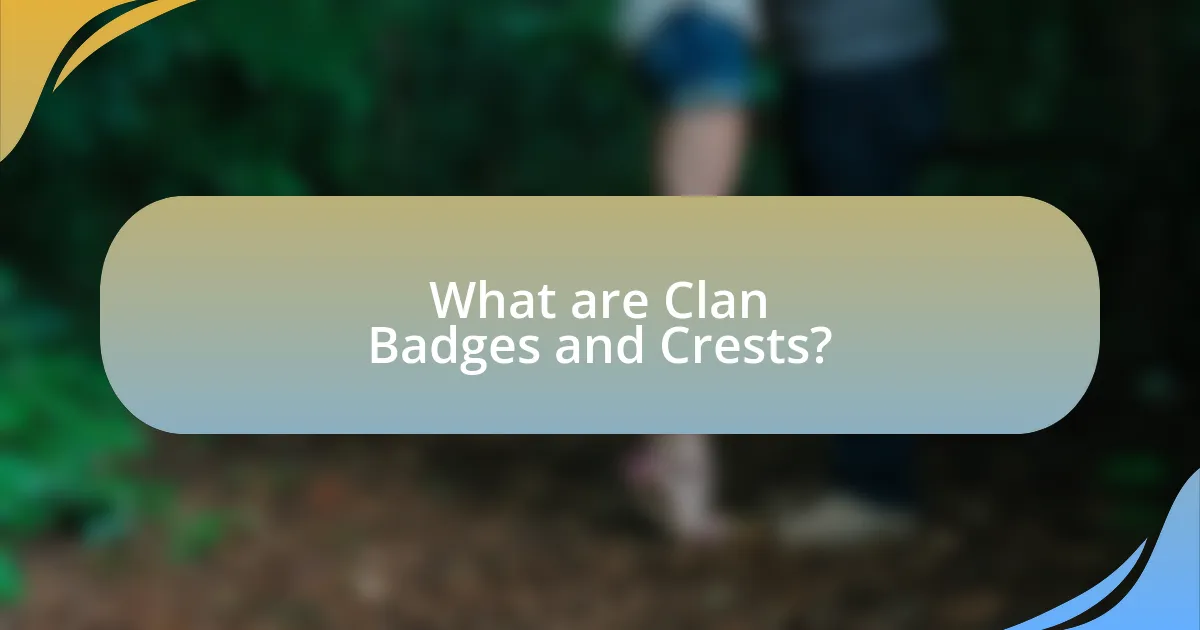
What are Clan Badges and Crests?
Clan badges and crests are distinctive symbols used to represent specific clans, particularly in Scottish culture. These emblems often incorporate elements such as animals, plants, or objects that hold significance to the clan’s history or values. For example, the crest typically appears above the clan badge and may feature a motto or a specific design that reflects the clan’s identity. Historically, these symbols served as a means of identification and unity among clan members, especially during conflicts or gatherings, reinforcing the clan’s heritage and lineage.
How do Clan Badges and Crests differ from each other?
Clan badges and crests serve distinct purposes in heraldry. Clan badges are specific symbols associated with a clan, often representing a particular family or lineage, and are typically used for identification and loyalty. In contrast, crests are part of a coat of arms and are usually displayed above the shield, symbolizing the achievements or qualities of the individual or family. The distinction lies in their usage: clan badges are communal symbols for clans, while crests are individual identifiers within the broader context of heraldry.
What historical significance do Clan Badges hold?
Clan badges hold historical significance as symbols of identity and allegiance for Scottish clans. These badges, often featuring a plant or animal associated with a particular clan, served to distinguish members and signify their heritage, lineage, and loyalty. Historically, clan badges were used in battle to identify allies and prevent friendly fire, reinforcing the importance of clan loyalty during conflicts. Additionally, they played a role in social gatherings and ceremonies, fostering a sense of community and belonging among clan members. The use of clan badges can be traced back to the 15th century, reflecting the deep-rooted traditions and cultural significance within Scottish society.
How have Clan Crests evolved over time?
Clan crests have evolved from simple symbols of identity in medieval Scotland to intricate designs representing family heritage and values. Initially, these crests served as identifiers for clans during battles, often featuring animals or objects that symbolized strength or loyalty. Over time, the designs became more elaborate, incorporating elements like mottoes and decorative flourishes, reflecting the clan’s history and achievements. Historical records indicate that by the 16th century, clan crests were standardized in heraldry, allowing for greater recognition and pride among clan members. This evolution illustrates the transition from functional identifiers to symbols of cultural significance and familial pride.
Why are Clan Badges and Crests important in cultural identity?
Clan badges and crests are important in cultural identity because they serve as symbols of heritage, lineage, and belonging. These emblems represent the history and values of a clan, fostering a sense of unity among its members. Historically, clan badges and crests were used to identify individuals in battle and signify allegiance, which reinforced social structures and community ties. For instance, in Scottish culture, specific designs and motifs are associated with particular clans, making them recognizable and significant to their members. This connection to ancestry and tradition enhances cultural pride and continuity, ensuring that the legacy of the clan is preserved across generations.
What role do they play in representing lineage and heritage?
Clan badges and crests serve as visual symbols that represent lineage and heritage by encapsulating the identity, history, and values of a specific family or clan. These emblems often incorporate elements such as animals, plants, or colors that are significant to the clan’s ancestry, thereby linking members to their forebears and cultural traditions. For instance, the use of specific motifs in Scottish heraldry reflects the clan’s geographical origins and historical achievements, reinforcing a sense of belonging and continuity among its members.
How do Clan Badges and Crests foster community among members?
Clan badges and crests foster community among members by serving as visual symbols of shared identity and heritage. These emblems create a sense of belonging, as they represent the values, history, and traditions of the clan. For instance, members often wear these badges during gatherings or events, reinforcing their connection to one another and to their collective past. Historical evidence shows that clans in Scotland used badges to signify loyalty and unity, which helped strengthen social bonds among members. This shared symbolism not only enhances group cohesion but also promotes pride in the clan’s legacy, further solidifying community ties.
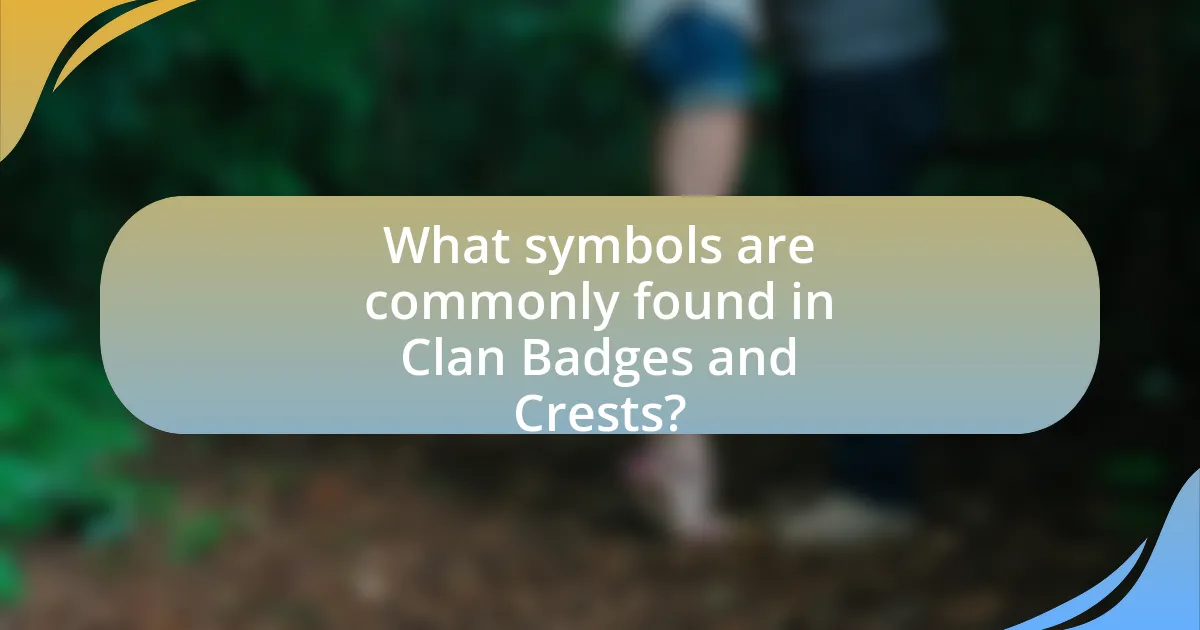
What symbols are commonly found in Clan Badges and Crests?
Clan badges and crests commonly feature symbols such as animals, plants, and objects that represent the clan’s heritage and values. For instance, animals like lions, eagles, and stags symbolize strength, courage, and nobility, while plants such as thistles or oak leaves may signify resilience and connection to the land. Additionally, objects like swords or shields often represent honor and protection. These symbols are rooted in historical significance, reflecting the clan’s identity and lineage, and are often derived from the clan’s motto or historical achievements.
What do specific colors in Clan Badges signify?
Specific colors in Clan Badges signify various attributes and values associated with the clan’s identity. For example, red often represents bravery and valor, while blue can symbolize loyalty and truth. Green typically signifies hope and joy, and black may denote strength and resilience. These color associations are rooted in historical traditions and heraldic practices, where colors were chosen to reflect the characteristics and ideals of the clan.
How do different animals represent various traits in Clan Crests?
Different animals in Clan Crests symbolize specific traits associated with the clan’s identity and values. For example, lions often represent bravery and strength, reflecting the warrior spirit of the clan, while eagles symbolize freedom and high vision, indicating leadership and aspiration. Additionally, bears can signify courage and tenacity, showcasing the clan’s resilience. Historical records, such as heraldic traditions, illustrate these associations, where the choice of animal is deeply rooted in the clan’s history and ethos, reinforcing their unique characteristics and aspirations.
What is the significance of plants and flowers in Clan Badges?
Plants and flowers in Clan Badges symbolize identity, heritage, and values of the clan. Each plant or flower often represents specific traits or historical connections relevant to the clan’s origins or geographical location. For instance, the thistle is emblematic of Scotland and signifies resilience, while the rose may denote beauty and honor. These botanical elements serve not only as decorative motifs but also as meaningful representations of the clan’s ethos and lineage, reinforcing a sense of belonging and pride among its members.
How do heraldic symbols convey messages in Clan Crests?
Heraldic symbols convey messages in Clan Crests by representing specific traits, values, and historical narratives associated with the clan. Each symbol, such as animals, colors, and objects, has distinct meanings; for example, a lion often symbolizes bravery, while the color blue can represent loyalty. These symbols serve as visual shorthand, allowing clans to communicate their identity, lineage, and achievements without words. Historically, the use of heraldry dates back to the 12th century, when knights displayed their crests on shields to identify themselves in battle, thus embedding personal and familial stories into the symbols. This practice has evolved, but the core function of conveying messages about honor, heritage, and allegiance remains central to the interpretation of Clan Crests.
What are the meanings behind common heraldic symbols?
Common heraldic symbols convey specific meanings that reflect values, traits, or historical significance. For instance, a lion symbolizes bravery and strength, while an eagle represents nobility and power. Colors also carry meanings; for example, gold signifies generosity, and blue denotes loyalty. These symbols and colors have been used historically in coats of arms to communicate the identity and virtues of families or clans, often rooted in medieval traditions where visual representation was crucial for recognition and status. The consistent use of these symbols across various heraldic traditions reinforces their meanings, making them integral to understanding clan badges and crests.
How do these symbols reflect the values of the clan?
Clan symbols, such as badges and crests, reflect the values of the clan by embodying its history, identity, and principles. These symbols often incorporate elements that signify bravery, loyalty, and heritage, which are core values upheld by the clan. For instance, a lion might represent courage and strength, while a tree could symbolize growth and stability. Historical records indicate that clans used these symbols to foster unity and pride among members, reinforcing their shared beliefs and traditions. Thus, the design and imagery of clan symbols serve as a visual representation of the clan’s foundational values and collective identity.
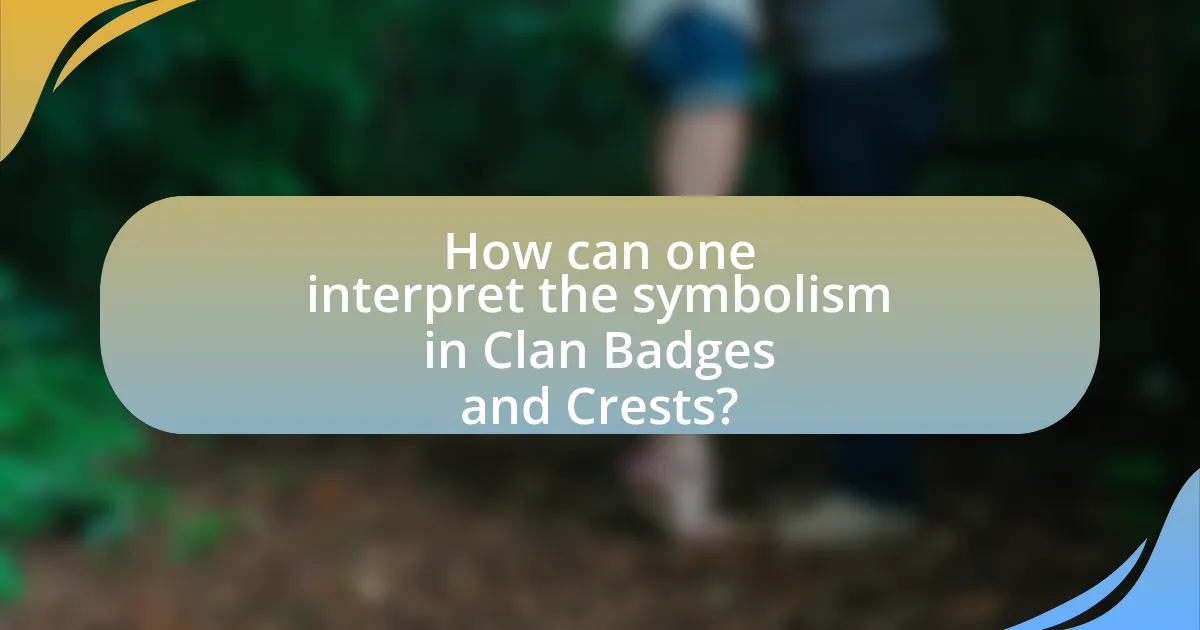
How can one interpret the symbolism in Clan Badges and Crests?
One can interpret the symbolism in Clan Badges and Crests by analyzing the specific elements depicted, such as animals, colors, and motifs, which often represent values, traits, or historical significance associated with the clan. For instance, a lion may symbolize bravery, while a thistle can represent resilience, particularly in Scottish heraldry. The colors used also carry meaning; for example, blue often signifies loyalty, and gold represents generosity. Historical context further enhances interpretation, as many symbols are rooted in the clan’s history or geographical origins, providing insight into their identity and heritage.
What steps should be taken to analyze a Clan Badge or Crest?
To analyze a Clan Badge or Crest, follow these steps: first, identify the elements present in the badge or crest, such as symbols, colors, and motifs. Next, research the historical context of the clan associated with the badge, including its origins, notable figures, and significant events. Then, interpret the symbolism of each element, considering how they reflect the clan’s values, heritage, and identity. Finally, compare the badge or crest with similar ones from other clans to understand its uniqueness and common themes within clan heraldry. This methodical approach ensures a comprehensive understanding of the badge or crest’s significance and meaning.
How can historical context enhance the understanding of a Clan Crest?
Historical context enhances the understanding of a Clan Crest by providing insights into the social, political, and cultural circumstances that shaped its design and significance. For instance, Clan Crests often reflect the historical alliances, conflicts, and achievements of a clan, such as symbols representing battles fought or notable leaders. The use of specific colors, animals, and motifs can be traced back to particular events or characteristics valued by the clan, such as bravery or loyalty. Understanding these elements allows individuals to appreciate the deeper meanings behind the crest, as well as its role in clan identity and heritage.
What resources are available for researching Clan Badges and Crests?
Resources for researching Clan Badges and Crests include heraldic databases, historical society archives, and specialized books on heraldry. The International Heraldry Society provides access to a wealth of information on clan symbols, while the Scottish Heraldry Society offers resources specifically focused on Scottish clans. Additionally, the “Dictionary of Scottish Heraldry” by Bruce Drummond serves as a comprehensive reference for understanding the meanings and origins of various clan badges and crests. Online platforms like Ancestry.com and FamilySearch also contain genealogical records that may include clan insignia.
What are some common misconceptions about Clan Badges and Crests?
Common misconceptions about clan badges and crests include the belief that they are interchangeable and that they represent the same thing. In reality, clan badges are specific to a particular clan and often include a plant or animal emblem, while crests are part of a coat of arms and represent the individual or family lineage. Additionally, many people mistakenly think that anyone can use a clan badge or crest, but these symbols are typically reserved for members of the clan or family to which they belong, governed by heraldic laws and traditions.
How do myths surrounding Clan symbols affect their interpretation?
Myths surrounding Clan symbols significantly influence their interpretation by shaping cultural narratives and perceptions. These myths often imbue symbols with historical significance, leading to varied interpretations based on regional beliefs and traditions. For instance, a clan’s crest may be interpreted differently depending on local legends that attribute specific meanings or stories to the imagery depicted. This can result in a divergence of understanding among clans, where one symbol may represent valor in one culture while symbolizing treachery in another. Such interpretations are reinforced by oral traditions and historical accounts, which further entrench these myths in the collective consciousness of the clan members.
What should one avoid when studying Clan Badges and Crests?
One should avoid relying on outdated or inaccurate sources when studying Clan Badges and Crests. Using such sources can lead to misunderstandings of the historical and cultural significance of these symbols, as many clan badges and crests have evolved over time and may have different meanings in various contexts. Accurate study requires consulting reputable historical texts, academic articles, and verified databases that provide context and clarity regarding the origins and interpretations of these emblems.
What practical tips can help in understanding Clan Badges and Crests?
To understand Clan Badges and Crests, start by researching the historical context and significance of each symbol, as these often reflect the clan’s heritage and values. Familiarize yourself with heraldic terminology, as terms like “escutcheon,” “supporters,” and “motto” are essential for interpreting the elements of a crest. Additionally, examining primary sources such as clan histories or heraldic registries can provide insights into the specific meanings behind colors, animals, and patterns used in the badges. Engaging with local historians or joining clan societies can also enhance your understanding through shared knowledge and resources.
How can one effectively document and share findings about Clan symbols?
To effectively document and share findings about Clan symbols, one should utilize a structured approach that includes thorough research, clear documentation, and accessible sharing methods. First, researchers must gather information from credible sources such as historical texts, academic journals, and expert interviews to ensure accuracy. For instance, the “Scottish Heraldry” by Sir James Balfour Paul provides detailed insights into clan symbols and their meanings.
Next, findings should be organized systematically, using digital tools like databases or spreadsheets to categorize symbols, their meanings, and historical contexts. This organization facilitates easy retrieval and analysis. Additionally, creating visual representations, such as infographics or digital presentations, can enhance understanding and engagement.
Finally, sharing findings can be accomplished through various platforms, including academic publications, social media, and community forums. Engaging with local clan societies or heritage organizations can also promote dissemination and discussion of the findings. By combining thorough research, systematic documentation, and diverse sharing methods, one can effectively communicate the significance of Clan symbols.
What best practices should be followed when creating a new Clan Badge or Crest?
When creating a new Clan Badge or Crest, it is essential to ensure that the design reflects the clan’s identity, values, and history. This involves selecting symbols, colors, and motifs that resonate with the clan’s heritage and purpose. For instance, using specific animals or plants that hold significance in the clan’s lore can enhance the badge’s meaning. Additionally, maintaining simplicity in design aids in recognition and reproduction, as overly complex designs can be difficult to replicate. Historical accuracy is also crucial; researching traditional heraldic practices can provide guidance on appropriate elements and their meanings. Furthermore, involving clan members in the design process fosters a sense of ownership and connection to the badge.
